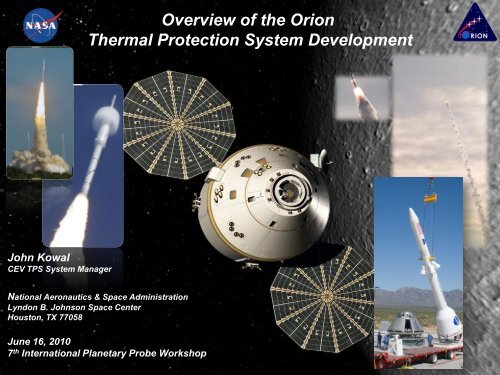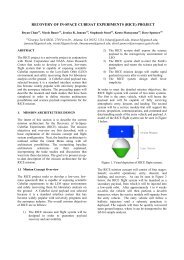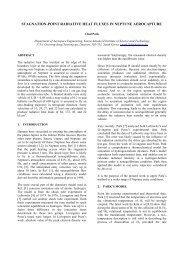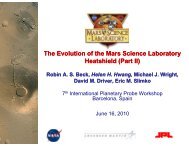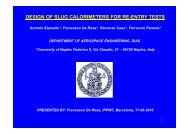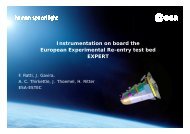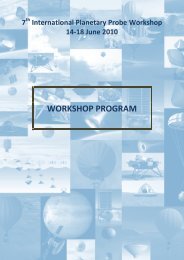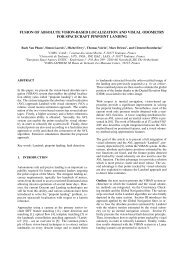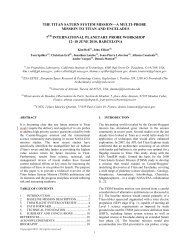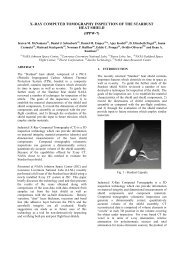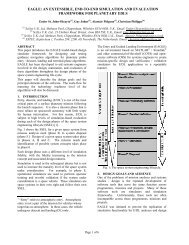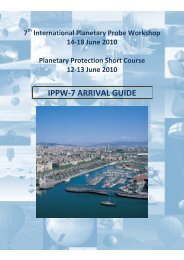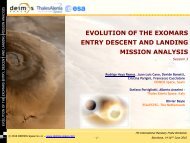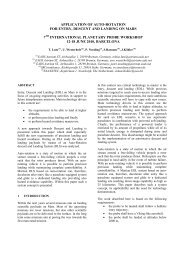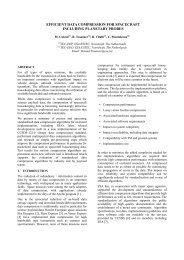Overview of the Orion Thermal Protection System Development
Overview of the Orion Thermal Protection System Development
Overview of the Orion Thermal Protection System Development
You also want an ePaper? Increase the reach of your titles
YUMPU automatically turns print PDFs into web optimized ePapers that Google loves.
Crew Exploration Vehicle Project Office<br />
<strong>Overview</strong> <strong>of</strong> <strong>the</strong> <strong>Orion</strong><br />
<strong>Thermal</strong> <strong>Protection</strong> <strong>System</strong> <strong>Development</strong><br />
John Kowal<br />
CEV TPS <strong>System</strong> Manager<br />
National Aeronautics & Space Administration<br />
Lyndon B. Johnson Space Center<br />
Houston, TX 77058<br />
June 16, 2010<br />
7 th International Planetary Probe Workshop<br />
IPPW 2010 – NASA/JSC/J. Kowal 1
Crew Exploration Vehicle Project Office<br />
Agenda<br />
• Background: Constellation & <strong>Orion</strong> <strong>Overview</strong><br />
• Backshell TPS <strong>Development</strong><br />
• Heatshield TPS <strong>Development</strong><br />
• Certification Approach<br />
• Conclusions<br />
IPPW 2010 – NASA/JSC/J. Kowal<br />
2
Crew Exploration Vehicle Project Office<br />
The Constellation Program was born from <strong>the</strong><br />
NASA Authorization Act <strong>of</strong> 2005 which stated….<br />
The Administrator shall establish a program to<br />
develop a sustained human presence on <strong>the</strong> moon,<br />
including a robust precursor program to promote<br />
exploration, science, commerce and U.S.<br />
preeminence in space, and as a stepping stone to<br />
future exploration <strong>of</strong> Mars and o<strong>the</strong>r destinations.<br />
IPPW 2010 – NASA/JSC/J. Kowal
Crew Exploration Vehicle Project Office<br />
NASA’s Constellation Program Plan<br />
for Space Exploration<br />
Safely fly <strong>the</strong> Space Shuttle and complete <strong>the</strong> International<br />
Space Station<br />
Develop and fly <strong>the</strong> <strong>Orion</strong> crew exploration vehicle by 2015<br />
Return to <strong>the</strong> moon by 2020<br />
Promote international and<br />
commercial participation<br />
in exploration<br />
IPPW 2010 – NASA/JSC/J. Kowal
Crew Exploration Vehicle Project Office<br />
Comparison <strong>of</strong> US Human Launch Vehicles<br />
100m<br />
300 ft<br />
Crew<br />
Lunar Lander<br />
Lunar Lander<br />
75m<br />
200 ft<br />
50m<br />
S-IVB<br />
1 J-2 engine<br />
110 tons<br />
Liquid Oxygen /<br />
Liquid Hydrogen<br />
S-II<br />
5 J-2 engines<br />
450 tons<br />
Liquid Oxygen /<br />
Liquid Hydrogen<br />
Upper Stage<br />
1 J-2X engine<br />
127 tons<br />
Liquid Oxygen /<br />
Liquid Hydrogen<br />
Earth Departure<br />
Stage (EDS)<br />
1 J-2X engine<br />
253 tons<br />
Core Stage<br />
6 RS-68B engines<br />
1590 tons<br />
Liquid Oxygen /<br />
Liquid Hydrogen<br />
100 ft<br />
25m<br />
S-IC<br />
5 F-1 Engines<br />
1770 tons<br />
Liquid Oxygen /<br />
Liquid Hydrogen<br />
5-segment<br />
solid rocket<br />
booster<br />
2 5.5-segment<br />
solid rocket<br />
boosters<br />
Saturn V<br />
Height: 361 ft (110m)<br />
119 tons to Low Earth Orbit<br />
45 tons to <strong>the</strong> moon<br />
US Space Shuttle<br />
Height: 184 ft (56m)<br />
25 tons to Low Earth<br />
Orbit<br />
Ares I<br />
Height: 322 ft (98m)<br />
22 tons to Low Earth Orbit<br />
Ares V<br />
Height: 358 ft (109m)<br />
175 tons to Low Earth Orbit<br />
63 tons cargo to moon<br />
IPPW 2010 – NASA/JSC/J. Kowal
Crew Exploration Vehicle Project Office<br />
• Transport up to 4 crew members to ISS and<br />
beyond<br />
• 210 day stay time in Earth or lunar orbit<br />
• Emergency lifeboat for entire ISS crew<br />
• Deliver pressurized cargo for ISS re-supply<br />
<strong>Orion</strong><br />
Key Driving Requirements<br />
IPPW 2010 – NASA/JSC/J. Kowal
Crew Exploration Vehicle Project Office<br />
<strong>Orion</strong> <strong>System</strong> Elements<br />
<strong>Orion</strong> consists <strong>of</strong> four<br />
functional modules<br />
Launch Abort <strong>System</strong> --<br />
emergency escape during launch<br />
Crew Module –<br />
crew and cargo transport<br />
Service Module –<br />
propulsion, electrical power, fluids storage<br />
Spacecraft Adapter –<br />
structural transition to launch vehicle<br />
IPPW 2010 – NASA/JSC/J. Kowal 7
Crew Exploration Vehicle Project Office<br />
Crew Module Configuration <strong>Overview</strong><br />
Backplane<br />
Stowage<br />
Side<br />
Window<br />
Forward<br />
Window<br />
Docking<br />
Tunnel<br />
Side<br />
Hatch<br />
Docking<br />
Hatch<br />
Similar to Apollo but…..<br />
IPPW 2010 – NASA/JSC/J. Kowal 8
Crew Exploration Vehicle Project Office<br />
<strong>Orion</strong> vs. Apollo<br />
• <strong>Orion</strong> shape is derived from Apollo, but approximately<br />
30% larger<br />
– Presents challenges to <strong>the</strong> TPS, including:<br />
• Increased heat loads<br />
• Manufacturing scale<br />
(3.9 m) (5.0 m)<br />
Comparison <strong>of</strong> Apollo to <strong>Orion</strong> floating in still water<br />
IPPW 2010 – NASA/JSC/J. Kowal 9
Crew Exploration Vehicle Project Office<br />
Crew Module <strong>Thermal</strong> <strong>Protection</strong> <strong>System</strong> (TPS) <strong>Overview</strong><br />
<strong>Thermal</strong> protection system<br />
• Defines OML aeroshape<br />
• Dissipates and isolates crew module from heat <strong>of</strong> reentry<br />
Heat shield<br />
• Textron Avcoat ablator<br />
• Composite carrier structure<br />
Backshell<br />
• TUFI coated AETB-8 tiles bonded to a SIP<br />
• 10 panels : composite laminate facesheets and<br />
titanium honeycomb core<br />
IPPW 2010 – NASA/JSC/J. Kowal<br />
Forward bay cover<br />
• TUFI coated AETB-8<br />
• FRSI blankets<br />
• 6 Panels: Composite face sheets<br />
& titanium honeycomb core<br />
10
Crew Exploration Vehicle Project Office<br />
Driving TPS Requirements<br />
• <strong>Thermal</strong>ly sized for Lunar return 2500 nmi skip<br />
trajectory* to maintain bondline and structure<br />
below allowable temperature limits<br />
– Also assess direct entry, aborts and<br />
emergency return modes<br />
• Single use system; nominal water landing<br />
• Provide and maintain vehicle outer mold line<br />
(OML), within allowable tolerances<br />
• Structurally designed for structural<br />
deflections, vibro-acoustic loads, pressure<br />
loads, <strong>the</strong>rmal stress and pyro loads for all<br />
flight phases (ascent, ascent abort, on-orbit and entry)<br />
• Satisfy subsystem allocations for:<br />
– Mass<br />
– Reliability<br />
– MMOD<br />
Total Heat Rate for all Trajectories using Max Qdot Total File<br />
0 200 400 600 800 1000 1200 1400 1600<br />
Time (seconds)<br />
EI1 Trajectory<br />
EI2 Trajectory<br />
EI3 Trajectory<br />
EI4 Trajectory<br />
EI5 Trajectory<br />
IPPW 2010 – NASA/JSC/J. Kowal 11
Crew Exploration Vehicle Project Office<br />
Backshell TPS <strong>Development</strong><br />
IPPW 2010 – NASA/JSC/J. Kowal<br />
12
Crew Exploration Vehicle Project Office<br />
Backshell TPS Configuration<br />
• Original baseline was SLA-561V<br />
with plasma sprayed aluminum<br />
coating for on-orbit <strong>the</strong>rmal control<br />
• TUFI coated AETB-8 tiles have<br />
replaced SLA for Backshell TPS<br />
material<br />
– AETB-8 tiles provide more<br />
mass-efficient MMOD<br />
protection<br />
– A low a/low e coating is still<br />
needed for tiles to provide<br />
on-orbit <strong>the</strong>rmal control<br />
• Tile thickness is determined by<br />
MMOD requirements, in additional<br />
to nominal <strong>the</strong>rmal requirements<br />
Pad Abort Test 2 (PA-2) Backshell Configuration<br />
IPPW 2010 – NASA/JSC/J. Kowal 13
Crew Exploration Vehicle Project Office<br />
Backshell <strong>Thermal</strong> <strong>Protection</strong> <strong>System</strong> (TPS) <strong>Overview</strong><br />
Backshell<br />
• TUFI coated AETB-8 tiles bonded to a SIP<br />
• 10 composite substrate panels: composite<br />
laminate facesheets and titanium<br />
honeycomb core<br />
• Panel tile thickness, substrate facesheet<br />
thickness, and core density tailored for<br />
<strong>the</strong>rmal & structural load, and MMOD<br />
requirements<br />
• Mechanically attached to pressure vessel<br />
with <strong>the</strong>rmal isolating brackets along <strong>the</strong>ir<br />
edges<br />
IPPW 2010 – NASA/JSC/J. Kowal<br />
Forward bay cover<br />
• TUFI coated AETB-8 tiles on 6<br />
separable conical panels<br />
• FRSI blankets on forward deck &<br />
docking hatch<br />
• Composite face sheets & titanium<br />
honeycomb core<br />
14
Crew Exploration Vehicle Project Office<br />
Heat Flux Distribution on Backshell<br />
Nominal Skip Entry<br />
FBC<br />
Panel C<br />
Panel A<br />
IPPW 2010 – NASA/JSC/J. Kowal 15
Crew Exploration Vehicle Project Office<br />
Backshell Tile Thickness Driven by MMOD<br />
Requirements<br />
A<br />
F<br />
E<br />
J<br />
B G<br />
I D<br />
H<br />
C<br />
Note: <strong>Thermal</strong> thickness is<br />
Lunar-driven<br />
IPPW 2010 – NASA/JSC/J. Kowal<br />
16
Crew Exploration Vehicle Project Office<br />
Heatshield TPS <strong>Development</strong><br />
IPPW 2010 – NASA/JSC/J. Kowal<br />
17
Crew Exploration Vehicle Project Office<br />
Heatshield <strong>Thermal</strong> <strong>Protection</strong> <strong>System</strong> (TPS) <strong>Overview</strong><br />
Heat shield<br />
• Textron Avcoat ablator <strong>of</strong> continuously varying<br />
thickness sized for ISS missions (Block 1)<br />
• Honeycomb applied in 1 center, 18 gore, & 18 shoulder<br />
panels<br />
• Composite carrier structure<br />
• Mounted to PV barrel section at 6 brackets<br />
IPPW 2010 – NASA/JSC/J. Kowal<br />
18
Crew Exploration Vehicle Project Office<br />
Avcoat <strong>Overview</strong><br />
AVCO 5026-39 HCG<br />
(Filled Epoxy Novalac in<br />
Fiberglas-Phenolic<br />
Honeycomb)<br />
Avcoat – <strong>Thermal</strong> <strong>Protection</strong> for Apollo<br />
Apollo 11<br />
Heat shield core<br />
Material Recovery Challenges<br />
• Some ingredients no longer available<br />
• Re-developing manufacturing processes<br />
• Training technicians to fill cells<br />
IPPW 2010 – NASA/JSC/J. Kowal 19
Crew Exploration Vehicle Project Office<br />
Comparison <strong>of</strong> Current Avcoat with Heritage Avcoat<br />
Spring ‘07 Avcoat<br />
March 1968 Avcoat<br />
IPPW 2010 – NASA/JSC/J. Kowal 20
Crew Exploration Vehicle Project Office<br />
Avcoat Design/Manufacturing Challenges<br />
AVCO technicians injecting ablator into honeycomb<br />
(Apollo command module had 300,000 cells)<br />
Automated cell-filling is being investigated<br />
Glass<br />
beads<br />
Silica in material complicates<br />
analytical modeling.<br />
Honeycomb shaping and filling procedures<br />
around shoulder need development<br />
IPPW 2010 – NASA/JSC/J. Kowal 21
Crew Exploration Vehicle Project Office<br />
Ground Test Article Hardware<br />
Backshell Panel C Tile Installation Complete<br />
IPPW 2010 – NASA/JSC/J. Kowal<br />
Heatshield Removed from Layup Mold<br />
22
Crew Exploration Vehicle Project Office<br />
Current Design Challenges Leading to CDR<br />
Examples:<br />
Pad 1<br />
0°<br />
Pad 6<br />
300°<br />
Pad 2<br />
60°<br />
Pad 5<br />
240°<br />
Pad 3<br />
120°<br />
Pad 4<br />
180°<br />
CM/SM Attachment<br />
Carrier<br />
Structure<br />
TPS<br />
Bracket to CM<br />
Multiple penetrations present<br />
additional TPS tile and seal design<br />
challenges during final design phase<br />
Compression<br />
Pad<br />
IPPW 2010 – NASA/JSC/J. Kowal<br />
Separation Bolt<br />
Bracket to SM<br />
23
Crew Exploration Vehicle Project Office<br />
Certification Approach<br />
IPPW 2010 – NASA/JSC/J. Kowal<br />
24
Crew Exploration Vehicle Project Office<br />
Inputs to <strong>the</strong> TPS Certification Plan<br />
Project Phases<br />
<strong>Development</strong> Qualification Acceptance<br />
Flight Phases<br />
Ground<br />
Transport<br />
Launch Pad<br />
Ascent<br />
Launch Abort<br />
On-orbit<br />
Entry<br />
Entry Abort<br />
Post-landing<br />
TPS Certification<br />
Plan<br />
Environments<br />
• Induced<br />
• Structural Deflections<br />
• Mechanical Loads<br />
• Acoustic Loads<br />
• Aerodynamic Loads<br />
• Convective Htg<br />
• Radiative Htg<br />
• Pressure<br />
• Shear Stress<br />
• Vibration Loads<br />
• Shock Loads<br />
• Accelerations<br />
• Venting<br />
• Natural<br />
Verification<br />
Methods<br />
IPPW 2010 – NASA/JSC/J. Kowal 25<br />
Test<br />
Analysis<br />
Similarity<br />
Inspection<br />
Demonstration<br />
Risk Management<br />
• Reliability calculations<br />
• Failure Mode assessment<br />
• Risk Mitigation
Crew Exploration Vehicle Project Office<br />
Test and Verification Progression<br />
Coupon<br />
Environmental Testing<br />
4-pt Bend<br />
Element<br />
Ground Test Article<br />
Material performance<br />
Properties<br />
Design allowables<br />
Model development<br />
Sub-component<br />
Sub-system performance<br />
Design development<br />
Model validation<br />
Design Verification<br />
Component/Vehicle<br />
IPPW 2010 – NASA/JSC/J. Kowal<br />
Qualification<br />
Acceptance<br />
26
Crew Exploration Vehicle Project Office<br />
Conclusions<br />
• The <strong>Orion</strong> <strong>the</strong>rmal protection system (TPS) design successfully<br />
supported <strong>the</strong> vehicle preliminary design review (PDR) in Jun-Aug<br />
2009<br />
– Backshell TPS consists <strong>of</strong> TUFI-coated AETB-8 tiles<br />
– Heatshield TPS is Apollo-heritage Avcoat ablator<br />
• The <strong>Orion</strong> project is in Phase C – developing <strong>the</strong> “build-to” design<br />
– CDR currently scheduled for February 2011<br />
• The overall Agency approach to future exploration, including <strong>the</strong> role<br />
<strong>of</strong> <strong>the</strong> <strong>Orion</strong> vehicle, is under revision at this time<br />
IPPW 2010 – NASA/JSC/J. Kowal 27


